OMG, will someone please tell this guy which century it is?
In round two of the Berkeley International 2008, David Pruess channeled Harry Nelson Pillsbury, circa 1899, with his brilliant 15. Bxh7! combination against Jesse Kraai. But not satisfied with that, in round four against Dale Haessel he dialed up the Cochrane Gambit (!) and then played a reprise of one of the greatest combinations in chess history, Charousek-Wollner from 1893 (!!). If there were a brilliancy prize in this tournament, David would already have won it twice over.
First of all, let’s see the immortal combination by Charousek. For ChessLecture subscribers, I discussed this in my lecture “Double Queen Sacrifices,” because it’s one of the extremely rare times in chess history when a player has sacrificed two queens in one game. Here is the position after Black’s move 16. …. Nc6:
White to play and win.
I’ve already given you a hint, by the way: look for a way for White to sacrifice two queens.
Got it? The winning combination is 17. Qe8+!! Rxe8 18. feQ+ Bxe8 19. Bxd6 mate. The final position deserves a diagram:
Remember the key ingredients: the Black king stuck on f8, the White bishop on c4 taking away his flight squares, the back-rank sacrifice to open the f-file, and finally the beautiful finishing touch, the double-check and mate with Bxd6. You’ll see all of them again!
Now let’s get to the game that David Pruess played yesterday.
David Pruess — Dale Haessel
Petroff Defense
1. e4 e5 2. Nf3 Nf6 3. Nxe5 d6 4. Nxf7!? …
The incredible Cochrane Gambit. White sacrifices a piece for two pawns on move 4, even though Black has apparently done nothing wrong. How can this be playable?!
Well, I could write a whole essay about this, but fortunately Jesse Kraai and Bill Paschall have already done it for me, in their lectures at www.chesslecture.com. If you play the Petrov, or play against the Petrov, you probably owe it to yourself to get a subscription to ChessLecture, just to hear their three lectures on the Cochrane Gambit (one by Jesse, two by Bill).
But if you’re too cheap or in too much of a hurry, here are their assessments:
Bill (lecturing from the Black point of view): “I agree that White has compensation for the piece, but not more… This [gambit] is not bad, and it is extremely dangerous.”
Jesse (lecturing from the White point of view): “This gambit is a lot about ideas. The most important thing is to understand the ideas, rather than to study lots of variations. There are two factors that are different from most gambits. First, the Black king is open to attack. [Jesse goes on to say that this is the first thing that most players will focus on.] That’s true, but that is not the most important thing. The biggest thing is central control. The idea is, by controlling the center, to make one or more of Black’s pieces bad. AFter you make it bad, then you can attack Black’s king.”
I completely endorse Jesse’s interpretation. In fact, I would say that the Cochrane Gambit is very close in spirit to the Bryntse Gambit, the queen sacrifice on move 6 of the Sicilian Defense that I played once upon a time against … David Pruess. In both openings, White checks on f7 and exposes Black’s king very early. But the fundamental idea behind both of them is not an immediate all-out attack on the king, but a slow and methodical buildup in the center that leaves Black’s pieces helpless, and which can be converted at a moment’s notice into a lethal assault against the king, which never succeeds in finding a secure home.
Lastly, I would say that even if the Cochrane Gambit is only equal at the grandmaster level, at the amateur level it must be close to a forced win for White.
Okay, back to our game.
5. Nc3 …
Not the most forceful move, but this was played by Topalov against Kramnik in Linares 1999, a game that Bill Paschall lectures about. David was probably familiar with that game. The somewhat more standard move is 5. d4, which Jesse Kraai covers in his lecture.
5. … Be7
Against 5. d4, Jesse says that 5. … g6, 5. … Be7, and 5. … c6 are all “playable, but misguided.” These moves all show that Black is more worried about king safety than about challenging White’s central superiority, which Jesse thinks is the more important positional factor. He says that “5. … c5 is Black’s best bet and what most strong players have been doing.” That is even more true after 5. Nc3, I would think.
6. d4 c5 7. Bc4+ Kf8
I wonder whether 7. … Be6, as in the Topalov-Kramnik game, might still be worth a try for Black. However, unlike Topalov-Kramnik, we have had the intervening moves d4 and … Be7, which tilt the position in White’s favor. Clearly if Black wants to strike at White’s center with … c5, he should do so as quickly as possible. Even the one interpolated move 5. … Be7 has made his position more difficult.
8. d5 a6 9. a4 Nbd7 10. f4 …
This is a good place to pause for a diagram, because you can really see here what the Cochrane Gambit is all about. Remember how Jesse talked about making one or more of Black’s pieces bad? Well, here I count five bad Black pieces!
- The bishop on e7, which has nowhere to go.
- The bishop on c8, which is blocked in by the d7 knight.
- The rook on a8, which is blocked in by the c8 bishop.
- The rook on h8, which is blocked in by the king.
- The queen on d8, which is blocked by the knight on d7 and the bishop on e7 and doesn’t quite know yet what it’s supposed to be doing.
Black’s only good pieces are his knights, and even then, his d7 knight is doing more harm than good at the moment (although ultimately, I think it plays a useful role by defending f6 and e5 and threatening … Nb6).
In short, Black’s camp is in total confusion, while White can continue playing simple, natural developing moves. The computer suggests 10. … Qe8 as Black’s best move, with the plan of … Bd8, … Ba5 (if White allows it), taking the knight on c3 and pressuring the e-pawn. Even here, however, when you play a few moves you find White getting a superior position. I am not convinced that the computer’s plan is any better than the plan that Haessel played, which was to put the bishop on f6 and trade the bishop for the c3 knight that way. And yet Haessel’s plan seems to lose almost by force!
10. … Ne8 11. O-O Bf6 12. Be3 Qe7 13. Qd3 Bxc3
It’s hard to see what else Black could have done. The break e4-e5 is coming, no matter what Black plays. The position is sort of like a super-horrible version of a Benoni Defense for Black.
14. bc Nef6
The computer suggests 14. … Nb6 as a way of avoiding a complete debacle: 15. Bb3 c4 (returning a pawn to ease the pressure) 16. Bxc4 Nxc4 17. Qxc4 Bf5! 18. e5 Rc8 19. Qb3. But even though Black has gotten in some nice, timely moves in … Bf5 and … Rc8, and thus managed to finish his development (sort of), the long-term problem of his king on f8 has not gone away, and White still stands much better.
Position after 14. … Nef6.
Okay, we talked earlier about White’s gradual buildup in the center. But at some point the gradual buildup has to stop and the swords have to come out, and now is the time. Black is seriously threatening to win the e4 pawn, and White can’t just let that happen. Instead he plays a dynamic, line-opening move, which is absolutely thematic:
15. e5! de 16. d6! …
This sort of break happens all the time in the Benoni Defense, and it’s extra-powerful here because of the way it opens up the a2-g8 diagonal for White’s bishop. The bishop is like one of those laser trip-lights in an action movie; it makes an invisible line right through the heart of Black’s position that Black’s king can’t step on or else he gets blown up.
16. … Qe8
Also hopeless is 16. … Qd8, for example 17. fe Nxe5 18. Qd5 Nxc4 19. Qxc4 with the threat of Rxf6.
17. fe Qxe5
Here, of course, 17. … Nxe5? would die instantly after 18. Rxf6.
18. Rae1 Nb6 19. Bf4 Qf5
White to play and win à la Charousek.
Now there are many ways for White to win. 20. Bh6 is brutal, and even the simple 20. Qe2 is quite good because it’s hard for Black to defend all the mating squares. But David finds a very elegant way. Now is the time to remember Charousek’s great combination. Can you see how to bring all the elements together?
20. d7! …
This move threatens to push to d8 with checkmate next move, or play Bd6 checkmate, or simply to win Black’s queen with Qxf5. Black’s next move manages to defend all three threats, but White has one more threat up his sleeve …
20. … Qxd3 21. Re8+!! Nxe8 22. Bd6 mate!
Compare the final position to the final position of the Charousek game:
Admittedly, this game didn’t have the double queen sacrifice that Charousek’s did, but I would argue that David’s combination is tantamount to a queen sac, because with his 21st move he showed that he was supremely indifferent to winning back his queen.
What can David do for an encore?
Well, actually winning the chess tournament would be a good start. That’s the main objective, after all — not scoring brilliant victories. So far, the people who are actually leading the tournament are the two Georgian GM’s, Giorgi Kacheishvili and Zviad Izoria, along with the dark horse Daniel Rensch. All three of them have 3-1 scores. Pruess is in a five-way tie for fourth at 2.5-1.5, with Friedel, Krush, Sharavdorj, and Esserman.
In round five we will see our first GM-versus-GM battles, Izoria versus Kacheishvili and also Bhat versus Kraai. Will Izoria and Kacheishvili go all out against each other, or take a draw and save their energy for games against the lower-rated players? We’ll see!
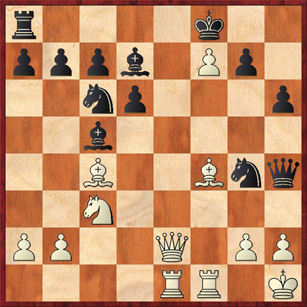
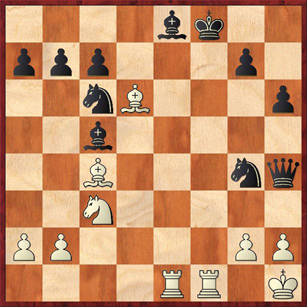
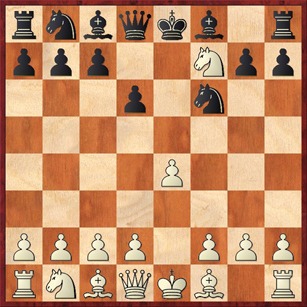
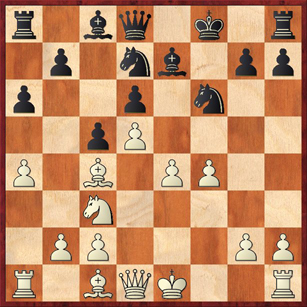
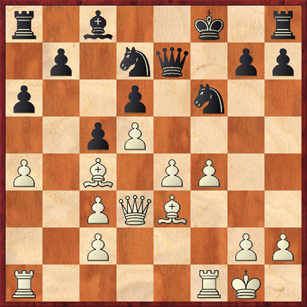





{ 2 comments… read them below or add one }
Wonderfull game! Wish i could play like that but then again sacrifacing a piece for two pawns is probably asking to much from my chess knowlegde and learned rules.
Wonderful game! I am soo looking toward to playing against the petroff now! Go Pruess!
{ 1 trackback }